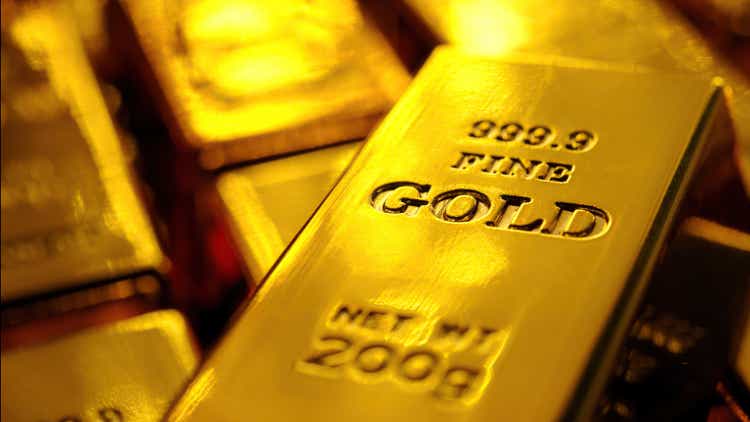
brightstars
Gold prices remained stable on Monday after rising for eight consecutive sessions and recording their best weekly gain since October last year, as market attention now turns to US CPI data to gauge the pace of rate cuts. US Federal Reserve rates. Golden Spot (HAUUSD: CUR) rose +0.13% to $2,180.25 an ounce by 6 a.m. ET.
In the run-up to that print, bullion’s medium-term outlook appears quite solid, but closer at hand there may be the case for a brief tactical pause, Bloomberg reports. “In this context, an in-line CPI reading could be enough to induce some consolidation, as it would likely push the US dollar higher, dampening gold’s appeal. The key therefore would be the depth and duration of any retracement.”
Gold hit an all-time high of $2,185.19 an ounce on Friday and is up about 14% this year. However, outflows from gold-backed ETFs continued, with total gold ETF holdings falling by 6.2t last week, according to ANZ. Central banks remain strong buyers.
“We remain positive on the price of gold for 2024 and continue to recommend it as a portfolio hedge. We expect gold to trend higher to $2,250 per ounce, but will wait for price setbacks to gain visibility, even if these turn out to be modest and short,” said Solita Marcelli, Chief Investment Officer Americas, UBS Global Wealth Management.
As for energy commodities, natural gas prices were trading in positive territory, as were both crude oil benchmarks. Oil prices fell early in the session on lingering demand concerns. “Concerns about weak demand in China have outweighed the extension of supply cuts by OPEC+,” Hiroyuki Kikukawa, president of NS Trading, a unit of Nissan Securities, told Reuters, adding that mixed signals coming from US employment data prompted some traders to adjust positions.
“However, losses will be limited by increased geopolitical risk, with the possibility that a ceasefire will not be reached in the war between Hamas and Israel and that the conflict could spread into Russia and its neighbors,” he said.
ANZ’s Daniel Hynes and Brian Martin wrote that Europe remains the hardest-hit region as shipments of petroleum products from Asia have fallen since January. Europe has become increasingly dependent on Asian oil products due to the war in Ukraine. “With OPEC+ extending its voluntary production cut agreement until the end of the second quarter of 2024, this could tighten the market as demand recovers from the seasonal lull.”
Stocks to watch: Nine Energy Services (NINE) +12%CSI Compressco (CCLP) +8%Ring Energy (REI) +8%Agritech origin (SEED) +11%5E Advanced Materials (FEAM) +11%Ramaco Resources (METC) +8%Taseko Mines (TGB) +6%, Amplify Energy (AMPY) -18%Delek Logistics (DKL) -12%Petroleo Brasileiro SA Petrobras ADR (PBR) -12%Icahn Enterprises (IEP) -8%.
Recent commodity price movements and a look at some ETFs
-
Power
- Crude Oil (CL1:COM) +0.16% at $78.14.
- Natural gas (NG1:COM) +0.71% at $1.82.
Metals
agriculture
Commodity ETFs
Gold ETFs:
- SPDR Gold Shares ETF (GLD)
- VanEck Gold Miners ETF (GDX)
- VanEck Junior Gold Miners ETF (GDXJ)
- iShares Gold Trust ETF (IAU)
- Direxion Daily Gold Miners Index Bull 2X Shares ETF (NUGT)
- Sprott Physical Gold Trust (PHYS)
Other metals ETFs:
- iShares Silver Trust ETF (SLV)
- Sprott Physical Silver Trust (PSLV)
- Global X Silver Miners ETF (SIL)
- US Copper Index Fund, LP ETF (CPER)
- abrdn Physical Palladium Shares ETF (PALL)
Oil ETFs:
- US Oil Fund, LP ETF (USO)
- Invesco DB Oil Fund ETF (DBO)
- US 12-Month Oil Fund, ETF LP (USL)
- US Brent Oil Fund, LP ETF (BNO)
- US Natural Gas Fund, LP ETF (UNG)
- US Gasoline Fund, LP ETF (UGA)
Agricultural ETFs:
- Invesco DB Agriculture Fund ETF (DBA)
- Teucrium Soy ETF (SOYB)
- ETF Teucrium Wheat (WEAT)
- ETF Teucrium Corn Fund (CORN)